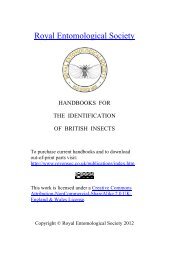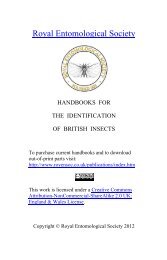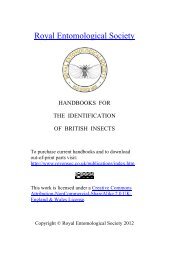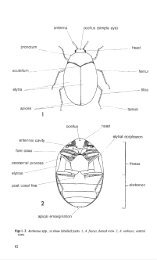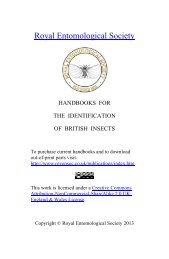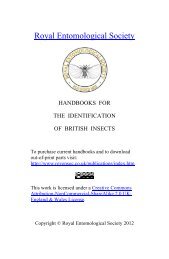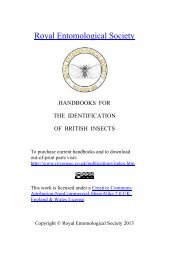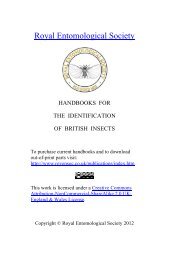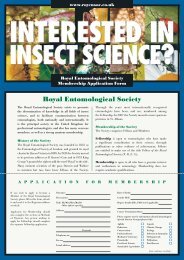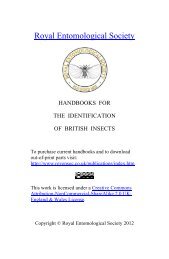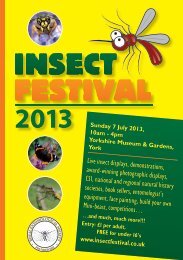Vol 10 Part 14. An introduction to the immature stages of British Flies ...
Vol 10 Part 14. An introduction to the immature stages of British Flies ...
Vol 10 Part 14. An introduction to the immature stages of British Flies ...
You also want an ePaper? Increase the reach of your titles
YUMPU automatically turns print PDFs into web optimized ePapers that Google loves.
To facilitate approximate identification a range <strong>of</strong> pupae and puparia is illustrated<br />
(figs 1<strong>10</strong>9-1286) for most families. Brauns (1954b) is useful for terrestrial species and<br />
o<strong>the</strong>r works dealing substantially with pupae are indicated under <strong>the</strong> appropriate<br />
families (see Ferrar, 1987 for Cyclorrhapha).<br />
Classification, nomenclature and use <strong>of</strong> keys<br />
As far possible <strong>the</strong> sequence <strong>of</strong> families, subfamilies, tribes and genera follows that <strong>of</strong><br />
<strong>the</strong> Diptera Check List (Smith et al., 1976) for <strong>the</strong> convenience <strong>of</strong> users <strong>of</strong> <strong>the</strong> Handbook<br />
series. Sometimes <strong>the</strong> only workable keys <strong>to</strong> larvae are based on a classification different<br />
from that now used for <strong>the</strong> adults (e.g. Syrphidae) and in such cases explana<strong>to</strong>ry<br />
comments are given. Where recent taxonomic research on adults has led <strong>to</strong> changes in<br />
<strong>the</strong> nomenclature, status, or generic placing <strong>of</strong> well-known species (such as pests)<br />
adequate synonymy is cited under <strong>the</strong> appropriate family treatment. Colloquial names<br />
for pest species, plant crops and o<strong>the</strong>r familiar plants and animals are given in addition<br />
<strong>to</strong> <strong>the</strong>ir scientific names at <strong>the</strong> first (or most important) citation.<br />
In using <strong>the</strong> keys it should constantly be borne in mind that many genera, species and<br />
even some families are unknown in <strong>the</strong> <strong>immature</strong> <strong>stages</strong> and <strong>the</strong>refore <strong>the</strong> full range <strong>of</strong><br />
morphological variety is unknown. <strong>Part</strong>icularly in <strong>the</strong> Acalyptratae couplets may lead<br />
<strong>to</strong> a choice <strong>of</strong> families and several families run through <strong>to</strong> more than one place in <strong>the</strong><br />
keys. It is intended that identifications should be attempted by combining use <strong>of</strong> <strong>the</strong><br />
keys with a consideration <strong>of</strong> habitat and pabulum (using <strong>the</strong> introduc<strong>to</strong>ry sections in<br />
combination with <strong>the</strong> index) in conjunction with <strong>the</strong> figures. In this way it should be<br />
possible <strong>to</strong> identify many <strong>of</strong> <strong>the</strong> Diptera most commonly found as larvae or pupae,<br />
including all species <strong>of</strong> economic, agricultural, medical and veterinary importance. As<br />
far as possible I have aimed <strong>to</strong> include all those Diptera whose <strong>immature</strong> <strong>stages</strong> are<br />
regularly submitted <strong>to</strong> en<strong>to</strong>mologists as 'economic enquiries'.<br />
Notes on <strong>the</strong> illustrations<br />
'As far as I am a judge, nothing would recommend en<strong>to</strong>mology more than<br />
some neat plates that should well express <strong>the</strong> generic distinctions <strong>of</strong> insects<br />
according <strong>to</strong> Linnaeus; for I am well assured that many people would study<br />
insects, could <strong>the</strong>y set out with a more adequate notion <strong>of</strong> those distinctions<br />
than can be conveyed at first by words alone.'<br />
Gilbert White, 1771<br />
The illustrations are meant <strong>to</strong> supplement <strong>the</strong> text with <strong>the</strong> following aims:<br />
(I) facilitating identification as far as family and tribe in conjunction with <strong>the</strong> keys;<br />
(2) <strong>to</strong> show <strong>the</strong> range <strong>of</strong> form and <strong>to</strong> illustrate particular environmental adaptations;<br />
(3) <strong>to</strong> facilitate <strong>the</strong> identification <strong>to</strong> genus and species <strong>of</strong> selected Diptera such as pest<br />
species, well known 'text-book' species and common readily encountered species <strong>of</strong><br />
value for teaching or demonstration, or frequently found during faunistic surveys.<br />
Attempts at identification by perusal <strong>of</strong> <strong>the</strong> whole insect figures alone should be<br />
practised with extreme caution making particular scrutiny <strong>of</strong> structural details and<br />
scanning all <strong>the</strong> figures. Convergence through adaptations <strong>to</strong> similar environmental<br />
requirements may result in remarkably similar superficial appearances between several<br />
taxonomically widely separated species, e.g. compare figs <strong>10</strong>27 and <strong>10</strong>59; figs 239 and<br />
903; figs 20 I, 617 and 938 etc.<br />
Allowance should be made for some variation in <strong>the</strong> structures illustrated, particularly<br />
in <strong>the</strong> pigmentation <strong>of</strong> <strong>the</strong> cephalopharyngeal skele<strong>to</strong>n. Apart from some<br />
expected variation within a species <strong>the</strong>re is evidence <strong>of</strong> geographic variation. Published<br />
30




